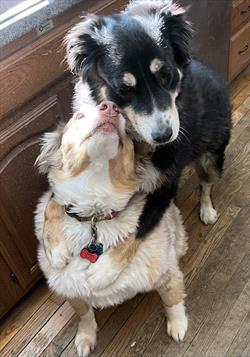It can be embarrassing when your dog humps or mounts another dog. Humping is seen in both male and female dogs of any age, whether neutered or intact. This behavior may be directed at other animals, people, objects, or the air. Some common reasons dogs may hump are:
- Displacement behavior: Normal behavior performed out of context signals frustration or stress. Commonly seen at dog parks or doggy daycare, this behavior shows your dog may not be comfortable in the environment due to the presence of other dogs or the length of playtime.
- Sexual behavior: Humping or mounting may be a sexual behavior if your pet is intact. This behavior may not decrease with neutering if it is anxiety-based.
- Medical behavior: There may be underlying issues such as cancer, urinary, endocrine, dermatological, or exposure to human prescription hormonal creams.
- Crowd control: Acting as “hall monitors”, dogs may hump to control another dog’s movement, even trying to hold on as the other dog lies down. This is often seen in group settings as a means of controlling or encouraging play.
- Play behavior: When part of play, humping would be brief, with a loose, wiggly body, open mouth, and relaxed face. Both dogs would appear relaxed and easily switch to another activity. Environmental factors: Dogs who are bored and have little physical or mental stimulation may mount. This could also represent displacement behavior.
Even if intended as play, mounting may cause other dogs to react negatively due to pain, invasion of space, or play preferences. Punishment is not recommended and can increase frustration and stress. Instead, redirect or remove your dog from the situation to give them a break. They may be overwhelmed by the other dogs or the environment. When reintroducing dogs, consider shorter play sessions or smaller groups. This may prevent your dog from becoming overstimulated.
If your dog is the only pet, ensure their mental and physical needs are met through enrichment, such as food puzzle toys, or walks. When walking, allow your dog an opportunity to choose the path and set the pace.
If the humping behavior becomes excessive, persistent, or causes problems, see your veterinarian to rule out medical conditions in addition to addressing your pet’s behavioral concerns.



